ECON7 Economics Assignment: Price Elasticity, Tariffs, and Australia
VerifiedAdded on 2021/05/31
|7
|1643
|166
Report
AI Summary
This economics assignment delves into two key areas: the concept of price elasticity of demand and the impact of US tariffs on steel and aluminum on Australian businesses. The first part of the assignment defines and explains price elasticity of demand, differentiating between elastic and inelastic demand, and identifying factors influencing it, such as the availability of substitutes, the cost of switching, and the degree of necessity. The second part examines the effects of US tariffs, imposed by President Trump, on Australian businesses. It analyzes both the short-term and long-term implications, considering Australia's exemption from the tariffs, its trade relationship with the US, and its potential role in the US-China trade war. The assignment concludes that while the direct impact on Australian businesses may be limited, the broader implications of a global trade war pose a significant concern, and recommends that businesses explore cost-saving opportunities and adopt a measured response to protectionist policies.
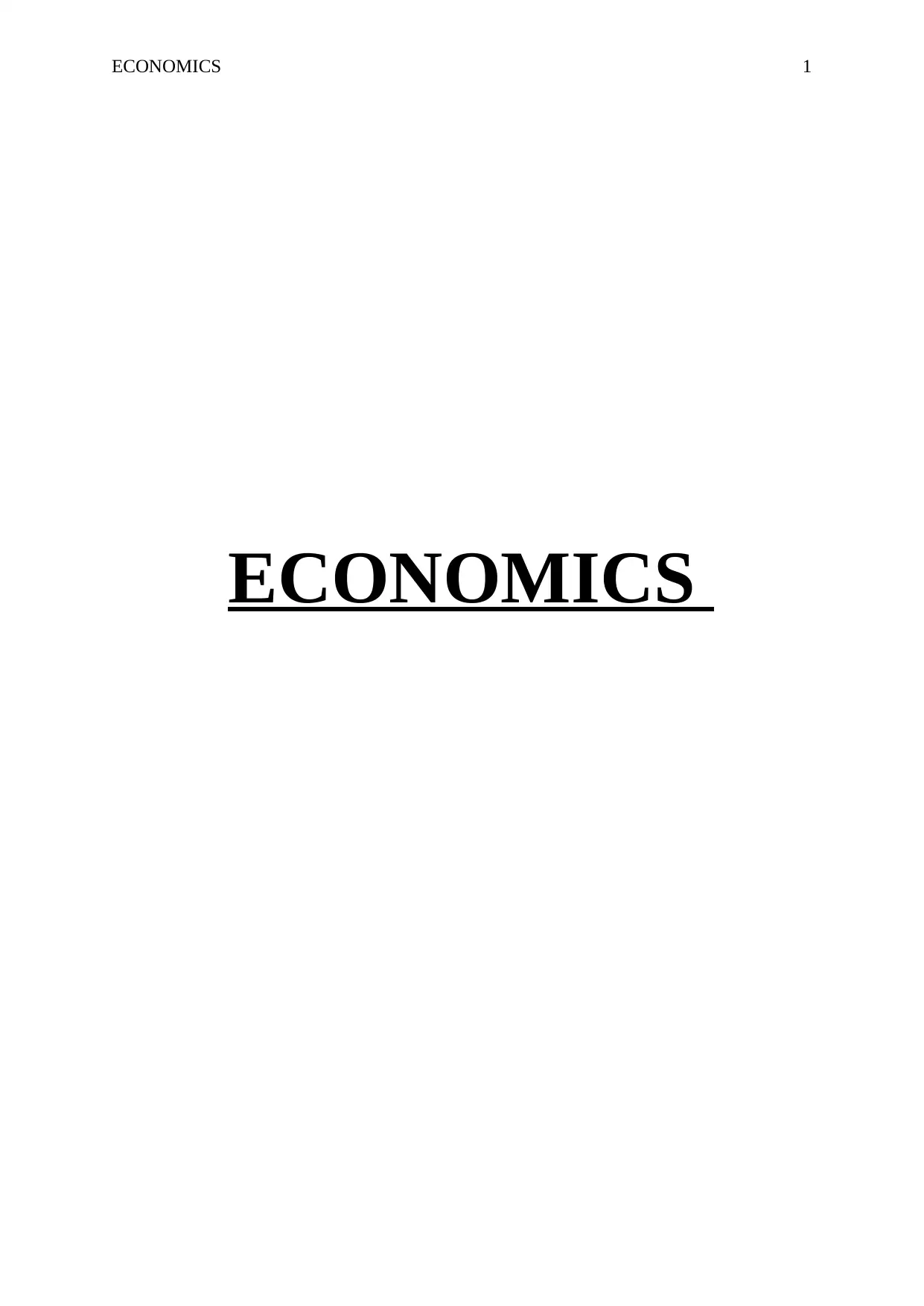
ECONOMICS 1
ECONOMICS
ECONOMICS
Paraphrase This Document
Need a fresh take? Get an instant paraphrase of this document with our AI Paraphraser

ECONOMICS 2
Answer 1:
The demand is considered to be elastic when there is a change in the demand of the product
when the price of that product undergoes a change.
.
The products that have an elastic demand include the luxury goods, expensive and the big
income groups, the products that are often purchased together and the goods that have many
substitutes and face a competitive market (Economic online, 2018).
Answer 1:
The demand is considered to be elastic when there is a change in the demand of the product
when the price of that product undergoes a change.
.
The products that have an elastic demand include the luxury goods, expensive and the big
income groups, the products that are often purchased together and the goods that have many
substitutes and face a competitive market (Economic online, 2018).
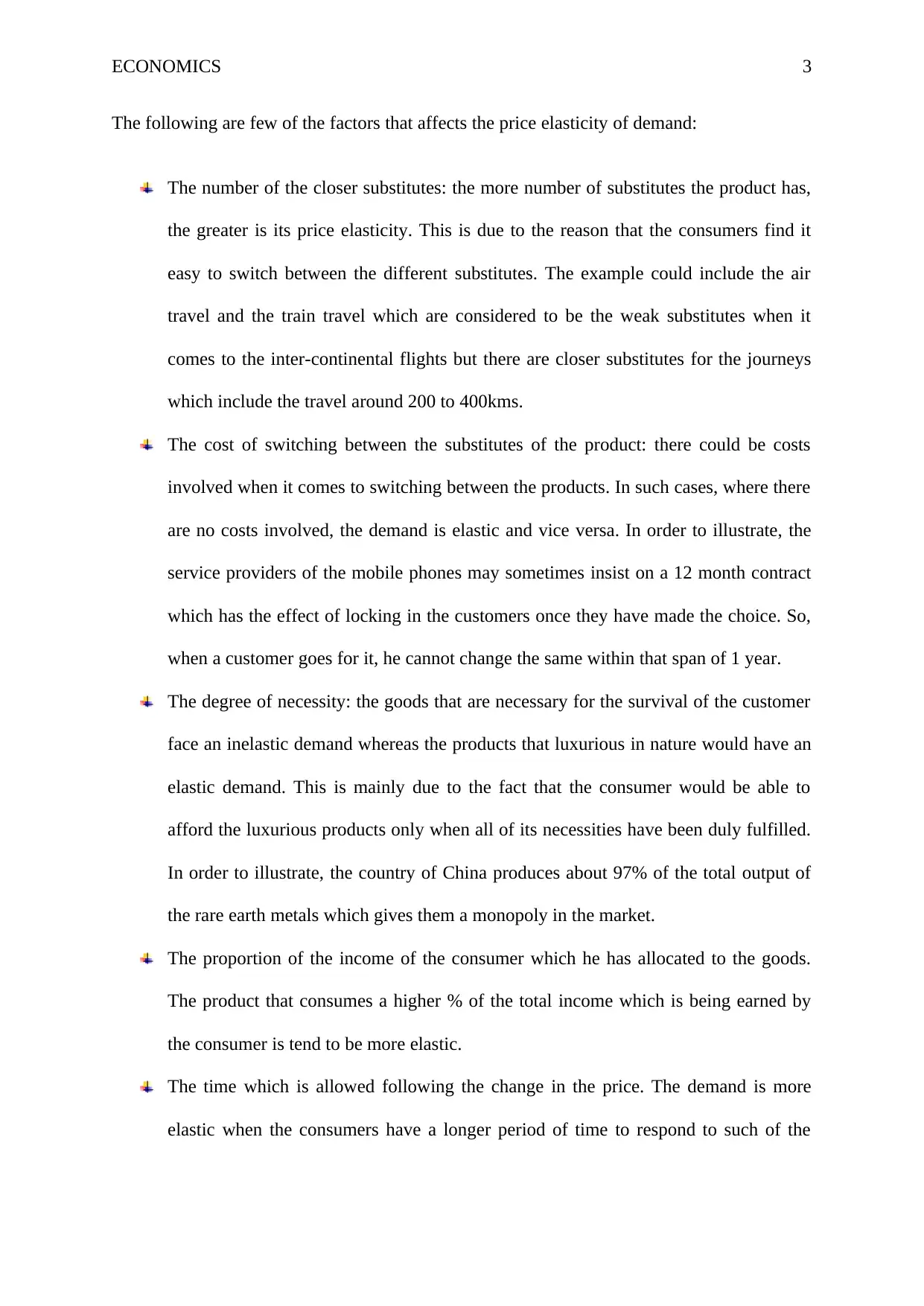
ECONOMICS 3
The following are few of the factors that affects the price elasticity of demand:
The number of the closer substitutes: the more number of substitutes the product has,
the greater is its price elasticity. This is due to the reason that the consumers find it
easy to switch between the different substitutes. The example could include the air
travel and the train travel which are considered to be the weak substitutes when it
comes to the inter-continental flights but there are closer substitutes for the journeys
which include the travel around 200 to 400kms.
The cost of switching between the substitutes of the product: there could be costs
involved when it comes to switching between the products. In such cases, where there
are no costs involved, the demand is elastic and vice versa. In order to illustrate, the
service providers of the mobile phones may sometimes insist on a 12 month contract
which has the effect of locking in the customers once they have made the choice. So,
when a customer goes for it, he cannot change the same within that span of 1 year.
The degree of necessity: the goods that are necessary for the survival of the customer
face an inelastic demand whereas the products that luxurious in nature would have an
elastic demand. This is mainly due to the fact that the consumer would be able to
afford the luxurious products only when all of its necessities have been duly fulfilled.
In order to illustrate, the country of China produces about 97% of the total output of
the rare earth metals which gives them a monopoly in the market.
The proportion of the income of the consumer which he has allocated to the goods.
The product that consumes a higher % of the total income which is being earned by
the consumer is tend to be more elastic.
The time which is allowed following the change in the price. The demand is more
elastic when the consumers have a longer period of time to respond to such of the
The following are few of the factors that affects the price elasticity of demand:
The number of the closer substitutes: the more number of substitutes the product has,
the greater is its price elasticity. This is due to the reason that the consumers find it
easy to switch between the different substitutes. The example could include the air
travel and the train travel which are considered to be the weak substitutes when it
comes to the inter-continental flights but there are closer substitutes for the journeys
which include the travel around 200 to 400kms.
The cost of switching between the substitutes of the product: there could be costs
involved when it comes to switching between the products. In such cases, where there
are no costs involved, the demand is elastic and vice versa. In order to illustrate, the
service providers of the mobile phones may sometimes insist on a 12 month contract
which has the effect of locking in the customers once they have made the choice. So,
when a customer goes for it, he cannot change the same within that span of 1 year.
The degree of necessity: the goods that are necessary for the survival of the customer
face an inelastic demand whereas the products that luxurious in nature would have an
elastic demand. This is mainly due to the fact that the consumer would be able to
afford the luxurious products only when all of its necessities have been duly fulfilled.
In order to illustrate, the country of China produces about 97% of the total output of
the rare earth metals which gives them a monopoly in the market.
The proportion of the income of the consumer which he has allocated to the goods.
The product that consumes a higher % of the total income which is being earned by
the consumer is tend to be more elastic.
The time which is allowed following the change in the price. The demand is more
elastic when the consumers have a longer period of time to respond to such of the
⊘ This is a preview!⊘
Do you want full access?
Subscribe today to unlock all pages.

Trusted by 1+ million students worldwide
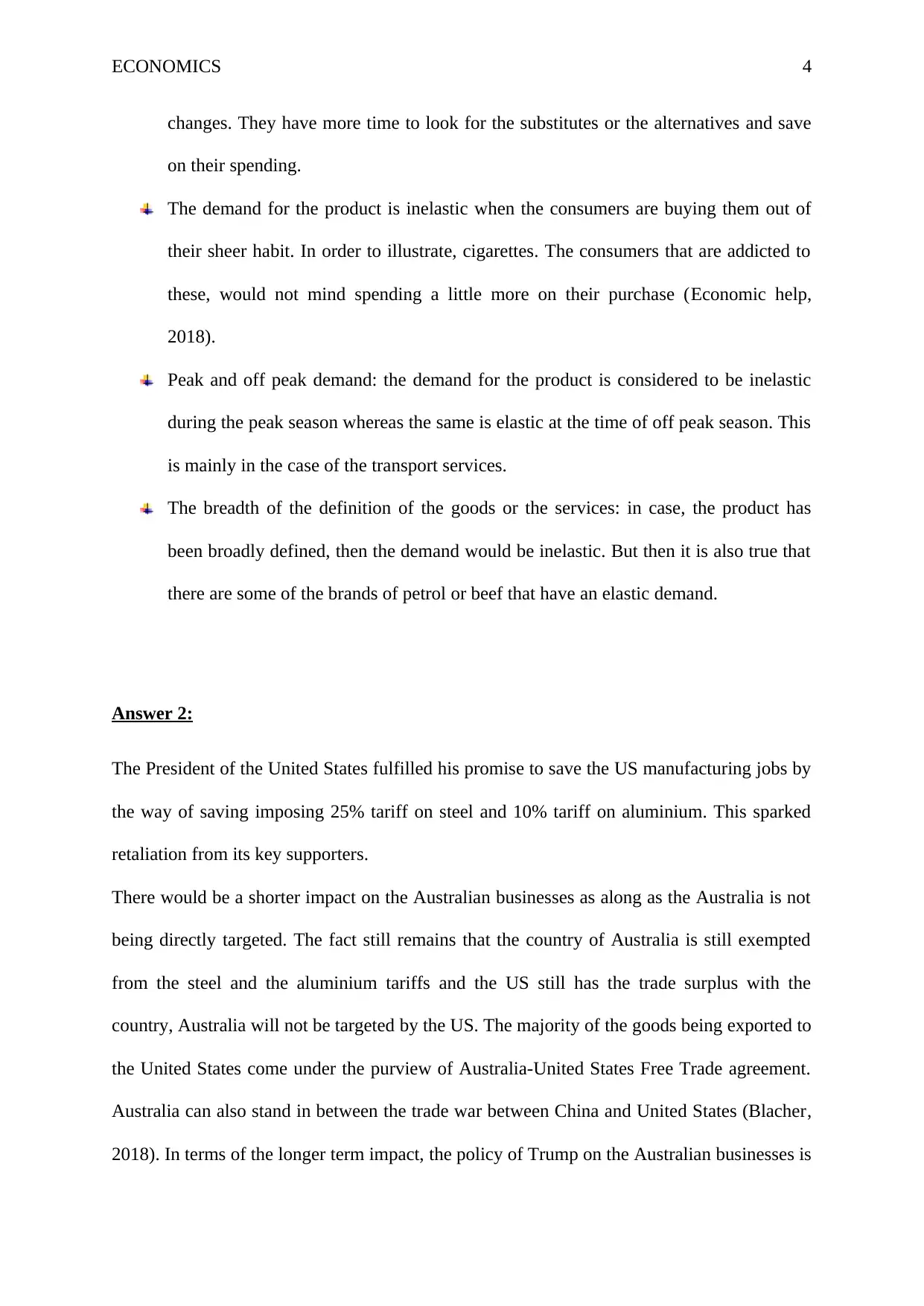
ECONOMICS 4
changes. They have more time to look for the substitutes or the alternatives and save
on their spending.
The demand for the product is inelastic when the consumers are buying them out of
their sheer habit. In order to illustrate, cigarettes. The consumers that are addicted to
these, would not mind spending a little more on their purchase (Economic help,
2018).
Peak and off peak demand: the demand for the product is considered to be inelastic
during the peak season whereas the same is elastic at the time of off peak season. This
is mainly in the case of the transport services.
The breadth of the definition of the goods or the services: in case, the product has
been broadly defined, then the demand would be inelastic. But then it is also true that
there are some of the brands of petrol or beef that have an elastic demand.
Answer 2:
The President of the United States fulfilled his promise to save the US manufacturing jobs by
the way of saving imposing 25% tariff on steel and 10% tariff on aluminium. This sparked
retaliation from its key supporters.
There would be a shorter impact on the Australian businesses as along as the Australia is not
being directly targeted. The fact still remains that the country of Australia is still exempted
from the steel and the aluminium tariffs and the US still has the trade surplus with the
country, Australia will not be targeted by the US. The majority of the goods being exported to
the United States come under the purview of Australia-United States Free Trade agreement.
Australia can also stand in between the trade war between China and United States (Blacher,
2018). In terms of the longer term impact, the policy of Trump on the Australian businesses is
changes. They have more time to look for the substitutes or the alternatives and save
on their spending.
The demand for the product is inelastic when the consumers are buying them out of
their sheer habit. In order to illustrate, cigarettes. The consumers that are addicted to
these, would not mind spending a little more on their purchase (Economic help,
2018).
Peak and off peak demand: the demand for the product is considered to be inelastic
during the peak season whereas the same is elastic at the time of off peak season. This
is mainly in the case of the transport services.
The breadth of the definition of the goods or the services: in case, the product has
been broadly defined, then the demand would be inelastic. But then it is also true that
there are some of the brands of petrol or beef that have an elastic demand.
Answer 2:
The President of the United States fulfilled his promise to save the US manufacturing jobs by
the way of saving imposing 25% tariff on steel and 10% tariff on aluminium. This sparked
retaliation from its key supporters.
There would be a shorter impact on the Australian businesses as along as the Australia is not
being directly targeted. The fact still remains that the country of Australia is still exempted
from the steel and the aluminium tariffs and the US still has the trade surplus with the
country, Australia will not be targeted by the US. The majority of the goods being exported to
the United States come under the purview of Australia-United States Free Trade agreement.
Australia can also stand in between the trade war between China and United States (Blacher,
2018). In terms of the longer term impact, the policy of Trump on the Australian businesses is
Paraphrase This Document
Need a fresh take? Get an instant paraphrase of this document with our AI Paraphraser
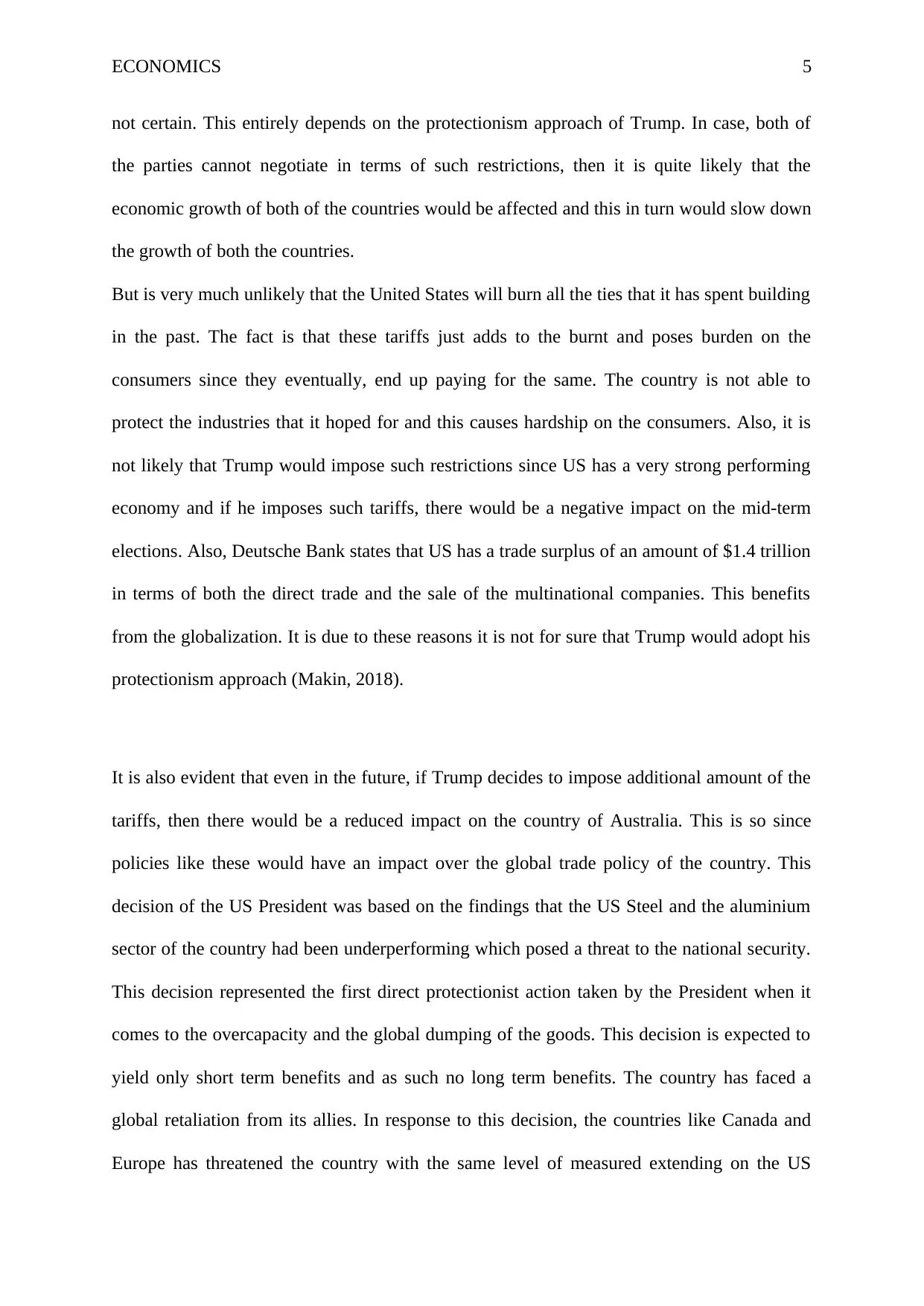
ECONOMICS 5
not certain. This entirely depends on the protectionism approach of Trump. In case, both of
the parties cannot negotiate in terms of such restrictions, then it is quite likely that the
economic growth of both of the countries would be affected and this in turn would slow down
the growth of both the countries.
But is very much unlikely that the United States will burn all the ties that it has spent building
in the past. The fact is that these tariffs just adds to the burnt and poses burden on the
consumers since they eventually, end up paying for the same. The country is not able to
protect the industries that it hoped for and this causes hardship on the consumers. Also, it is
not likely that Trump would impose such restrictions since US has a very strong performing
economy and if he imposes such tariffs, there would be a negative impact on the mid-term
elections. Also, Deutsche Bank states that US has a trade surplus of an amount of $1.4 trillion
in terms of both the direct trade and the sale of the multinational companies. This benefits
from the globalization. It is due to these reasons it is not for sure that Trump would adopt his
protectionism approach (Makin, 2018).
It is also evident that even in the future, if Trump decides to impose additional amount of the
tariffs, then there would be a reduced impact on the country of Australia. This is so since
policies like these would have an impact over the global trade policy of the country. This
decision of the US President was based on the findings that the US Steel and the aluminium
sector of the country had been underperforming which posed a threat to the national security.
This decision represented the first direct protectionist action taken by the President when it
comes to the overcapacity and the global dumping of the goods. This decision is expected to
yield only short term benefits and as such no long term benefits. The country has faced a
global retaliation from its allies. In response to this decision, the countries like Canada and
Europe has threatened the country with the same level of measured extending on the US
not certain. This entirely depends on the protectionism approach of Trump. In case, both of
the parties cannot negotiate in terms of such restrictions, then it is quite likely that the
economic growth of both of the countries would be affected and this in turn would slow down
the growth of both the countries.
But is very much unlikely that the United States will burn all the ties that it has spent building
in the past. The fact is that these tariffs just adds to the burnt and poses burden on the
consumers since they eventually, end up paying for the same. The country is not able to
protect the industries that it hoped for and this causes hardship on the consumers. Also, it is
not likely that Trump would impose such restrictions since US has a very strong performing
economy and if he imposes such tariffs, there would be a negative impact on the mid-term
elections. Also, Deutsche Bank states that US has a trade surplus of an amount of $1.4 trillion
in terms of both the direct trade and the sale of the multinational companies. This benefits
from the globalization. It is due to these reasons it is not for sure that Trump would adopt his
protectionism approach (Makin, 2018).
It is also evident that even in the future, if Trump decides to impose additional amount of the
tariffs, then there would be a reduced impact on the country of Australia. This is so since
policies like these would have an impact over the global trade policy of the country. This
decision of the US President was based on the findings that the US Steel and the aluminium
sector of the country had been underperforming which posed a threat to the national security.
This decision represented the first direct protectionist action taken by the President when it
comes to the overcapacity and the global dumping of the goods. This decision is expected to
yield only short term benefits and as such no long term benefits. The country has faced a
global retaliation from its allies. In response to this decision, the countries like Canada and
Europe has threatened the country with the same level of measured extending on the US
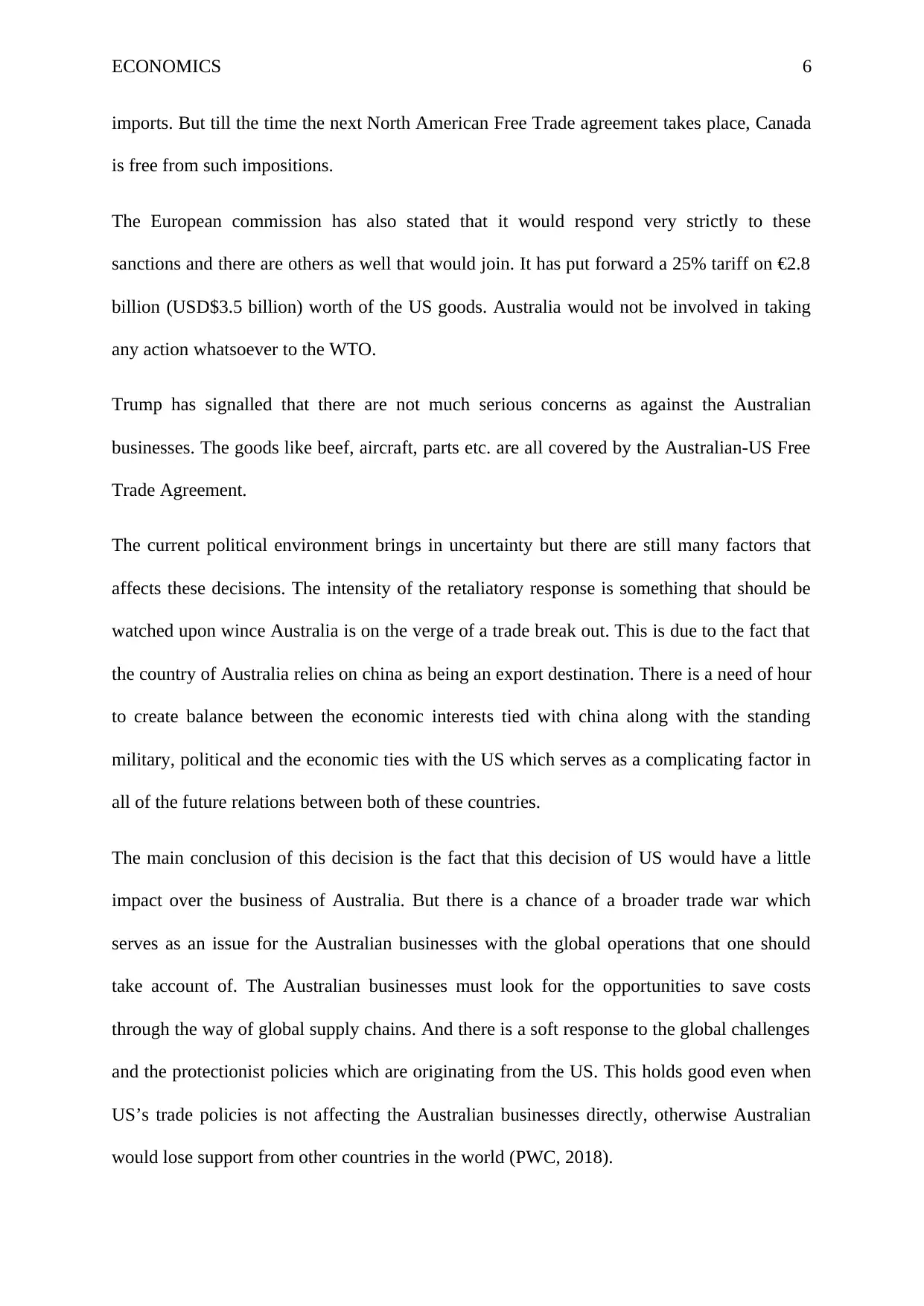
ECONOMICS 6
imports. But till the time the next North American Free Trade agreement takes place, Canada
is free from such impositions.
The European commission has also stated that it would respond very strictly to these
sanctions and there are others as well that would join. It has put forward a 25% tariff on €2.8
billion (USD$3.5 billion) worth of the US goods. Australia would not be involved in taking
any action whatsoever to the WTO.
Trump has signalled that there are not much serious concerns as against the Australian
businesses. The goods like beef, aircraft, parts etc. are all covered by the Australian-US Free
Trade Agreement.
The current political environment brings in uncertainty but there are still many factors that
affects these decisions. The intensity of the retaliatory response is something that should be
watched upon wince Australia is on the verge of a trade break out. This is due to the fact that
the country of Australia relies on china as being an export destination. There is a need of hour
to create balance between the economic interests tied with china along with the standing
military, political and the economic ties with the US which serves as a complicating factor in
all of the future relations between both of these countries.
The main conclusion of this decision is the fact that this decision of US would have a little
impact over the business of Australia. But there is a chance of a broader trade war which
serves as an issue for the Australian businesses with the global operations that one should
take account of. The Australian businesses must look for the opportunities to save costs
through the way of global supply chains. And there is a soft response to the global challenges
and the protectionist policies which are originating from the US. This holds good even when
US’s trade policies is not affecting the Australian businesses directly, otherwise Australian
would lose support from other countries in the world (PWC, 2018).
imports. But till the time the next North American Free Trade agreement takes place, Canada
is free from such impositions.
The European commission has also stated that it would respond very strictly to these
sanctions and there are others as well that would join. It has put forward a 25% tariff on €2.8
billion (USD$3.5 billion) worth of the US goods. Australia would not be involved in taking
any action whatsoever to the WTO.
Trump has signalled that there are not much serious concerns as against the Australian
businesses. The goods like beef, aircraft, parts etc. are all covered by the Australian-US Free
Trade Agreement.
The current political environment brings in uncertainty but there are still many factors that
affects these decisions. The intensity of the retaliatory response is something that should be
watched upon wince Australia is on the verge of a trade break out. This is due to the fact that
the country of Australia relies on china as being an export destination. There is a need of hour
to create balance between the economic interests tied with china along with the standing
military, political and the economic ties with the US which serves as a complicating factor in
all of the future relations between both of these countries.
The main conclusion of this decision is the fact that this decision of US would have a little
impact over the business of Australia. But there is a chance of a broader trade war which
serves as an issue for the Australian businesses with the global operations that one should
take account of. The Australian businesses must look for the opportunities to save costs
through the way of global supply chains. And there is a soft response to the global challenges
and the protectionist policies which are originating from the US. This holds good even when
US’s trade policies is not affecting the Australian businesses directly, otherwise Australian
would lose support from other countries in the world (PWC, 2018).
⊘ This is a preview!⊘
Do you want full access?
Subscribe today to unlock all pages.

Trusted by 1+ million students worldwide
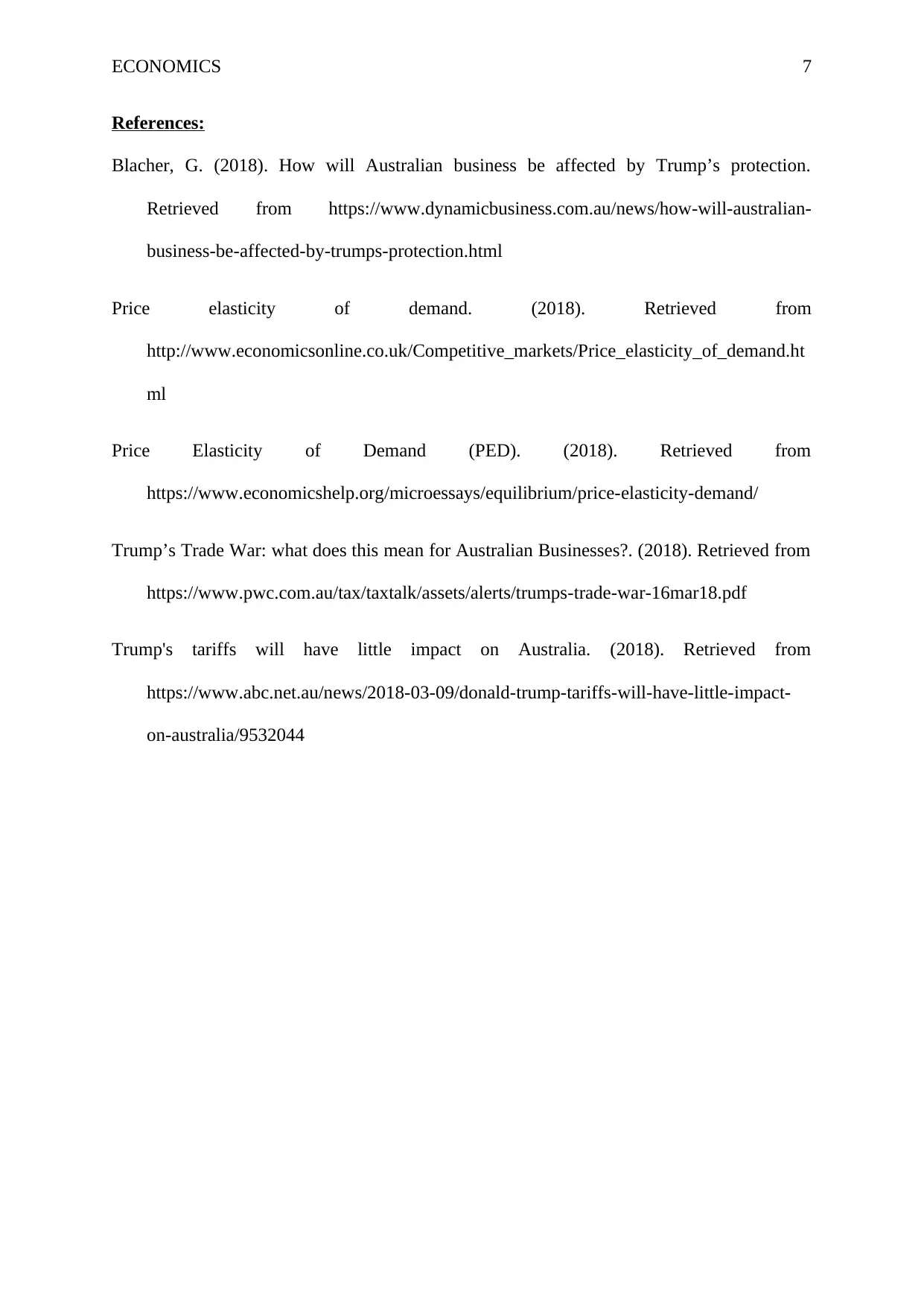
ECONOMICS 7
References:
Blacher, G. (2018). How will Australian business be affected by Trump’s protection.
Retrieved from https://www.dynamicbusiness.com.au/news/how-will-australian-
business-be-affected-by-trumps-protection.html
Price elasticity of demand. (2018). Retrieved from
http://www.economicsonline.co.uk/Competitive_markets/Price_elasticity_of_demand.ht
ml
Price Elasticity of Demand (PED). (2018). Retrieved from
https://www.economicshelp.org/microessays/equilibrium/price-elasticity-demand/
Trump’s Trade War: what does this mean for Australian Businesses?. (2018). Retrieved from
https://www.pwc.com.au/tax/taxtalk/assets/alerts/trumps-trade-war-16mar18.pdf
Trump's tariffs will have little impact on Australia. (2018). Retrieved from
https://www.abc.net.au/news/2018-03-09/donald-trump-tariffs-will-have-little-impact-
on-australia/9532044
References:
Blacher, G. (2018). How will Australian business be affected by Trump’s protection.
Retrieved from https://www.dynamicbusiness.com.au/news/how-will-australian-
business-be-affected-by-trumps-protection.html
Price elasticity of demand. (2018). Retrieved from
http://www.economicsonline.co.uk/Competitive_markets/Price_elasticity_of_demand.ht
ml
Price Elasticity of Demand (PED). (2018). Retrieved from
https://www.economicshelp.org/microessays/equilibrium/price-elasticity-demand/
Trump’s Trade War: what does this mean for Australian Businesses?. (2018). Retrieved from
https://www.pwc.com.au/tax/taxtalk/assets/alerts/trumps-trade-war-16mar18.pdf
Trump's tariffs will have little impact on Australia. (2018). Retrieved from
https://www.abc.net.au/news/2018-03-09/donald-trump-tariffs-will-have-little-impact-
on-australia/9532044
1 out of 7
Related Documents
Your All-in-One AI-Powered Toolkit for Academic Success.
+13062052269
info@desklib.com
Available 24*7 on WhatsApp / Email
![[object Object]](/_next/static/media/star-bottom.7253800d.svg)
Unlock your academic potential
Copyright © 2020–2025 A2Z Services. All Rights Reserved. Developed and managed by ZUCOL.





